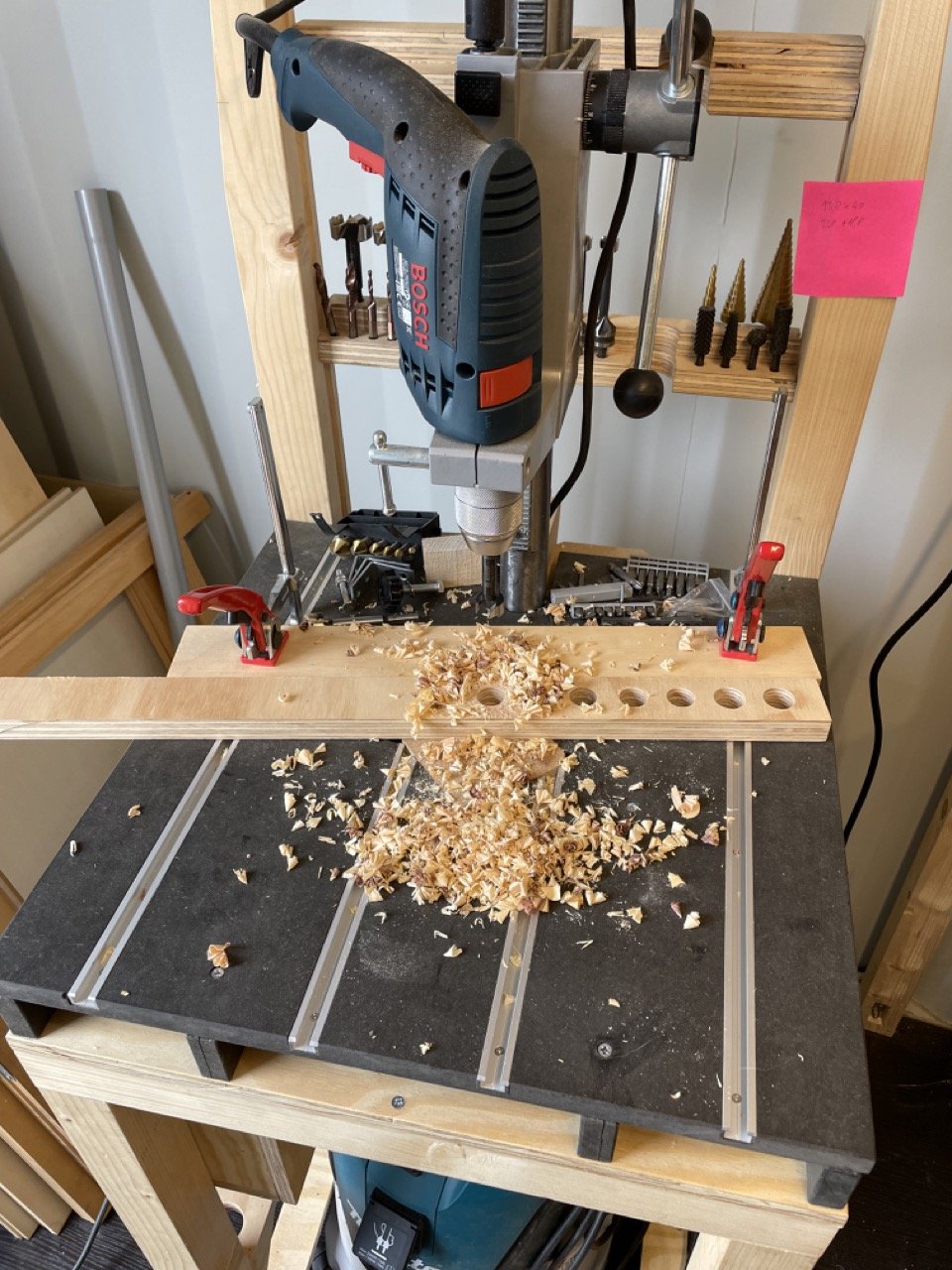Exploring Woodworking Jigs: An Introduction
Woodworking Jigs: the Secret to Precision, Efficiency and Safety
In woodworking precision is key. Safety, essential selfcare. The extension of your machine's capabilities opens up a whole new level of woodworking. To all these, jigs often are your solution. While jigs might not be the most glamorous tools in your workshop, their role is undeniably crucial. If you've ever found yourself marveling at how to make a safe x-cut, a tapered cut or ensure precise repeatability of a cut or drill, chances are high a jig will be involved in making it happen.
Jigs are not just tools to help you accomplish a certain cut, they also help you develop a mindset around your work. It is fascinating and inspiring how many people share their approaches to solve woodworking problems from their perspective within a specific project. For me getting into jigs opened up a whole new understanding of my woodworking.
Drill-press table
I would not want to miss this customized drill-press station a single day.
What Exactly is a Woodworking Jig?
Jigs can be bought (rather expensive), or you could take on the fun challenge to make one that someone shared on youtube, pinterest or their blog. That’s a perfect start, and in the process we find ourselves developing our own ideas and bring them into the jigs we build, and maybe also share it with the community later.
Back to the jig: a jig is an auxiliary tool used to expand control and motion of another tool. In woodworking, jigs serve as guides, ensuring that cuts are straight, angles are correct, and repetitive tasks are, well, repeatable, or simply safer. Think of them as the magic that helps transform raw wood into precise and beautifully crafted pieces.
The Variety of Jigs
Woodworking jigs come in a plentiful variety, each designed to simplify specific tasks. Here’s a glimpse at some I use a lot in my workshop all the time:
Table Saw Jigs: help ensure safe, precise cuts on your table saw.
x-cut sled: arguably the most important jig for table saw operations. It provides precise 90-degree cuts and enhanced safety compared to the stock miter gauge.
Features:
perfect support to guide a workpiece safely and precisely through the table saw blade producing an exact 90-degree cut
stop blocks for repeatability of multiple cuts
hold-downs to secure your work piece
taper jig: ideal for table legs and angled cuts, a taper jig ensures consistent angles across multiple pieces. it also lets you make a safe rip cut of a piece without a straight edge.
Features:
adjustable angle settings
hold-downs for workpiece security
reference lines for common angles
miter gauge: helps you making angled cuts from 0-90° in both directions on a table saw or other woodworking machinery.
Features:
protractor head with angle markings
locking mechanism to set angle
sliding bar that fits table slots
fence attachment capability
adjustable stops for repeat cuts
Drill Jig: ensuring holes are drilled accurately and consistently, a drill jig is invaluable for tasks that require precision alignment.
drillpress table:
Features:
t-tracks for clamping and attaching fences and stops
replaceable sacrificial insert in the center
wider surface area (larger than stock table)
fence that's easily adjustable and lockable
integrated storage for common drill bits and tools
solid mounting system to drill press base
Why Use a Jig?
Now, you might be thinking, "Can't I just eyeball and freehand it?" While the human eye is a wonderful tool, there are a few reasons to let jigs do the heavy lifting:
Precision: jigs eliminate guesswork and repeated measuring, providing a consistent reference point that leads to perfect cuts or drills every time. This is especially useful when working on complex joinery or repetitive tasks.
Efficiency: once a jig is set up, it speeds up the process, allowing you to produce work faster without sacrificing quality. Plus, the reduced need for measuring and marking saves time and minimizes mistakes.
Safety: using jigs secures your workpiece making your work so much safer and enjoyable
Extension: jigs in many cases widen your machines’ capabilities
Making Your Own Jigs
One of the most satisfying aspects of woodworking is creating custom jigs tailored to your tools and unique projects. All you need is some solid and straight scrap wood, a bit of creativity, and a good grasp of your requirements. Whether you're designing a jig to fit a specific angle or to accommodate an unusual cut, the process can be as much fun as the project itself. Also you will save a lot of money compared to buying a jig.
Tips for Using Jigs
Start Simple: If you're new to jigs, start with something straightforward, like a basic crosscut sled. As your confidence grows, you can tackle more complex designs.
Invest in Quality Materials: A jig is only as good as the materials used to make it. Use sturdy, straight wood or durable composites to ensure long-lasting performance (still can be cut-offs).
Keep Safety in Mind: Always ensure your jigs and work pieces are securely fastened and stable before starting work to prevent accidents.
Conclusion
Jigs like the x-cut sled for the table saw and the drillpress table I use daily. For me their utility is incredible. They open up a world of precision and efficiency, refining my craft and enhancing the quality of my projects. So, next time you're planning a woodworking endeavor, give a nod to the humble jig - it just might be the secret ingredient to your success as well.




